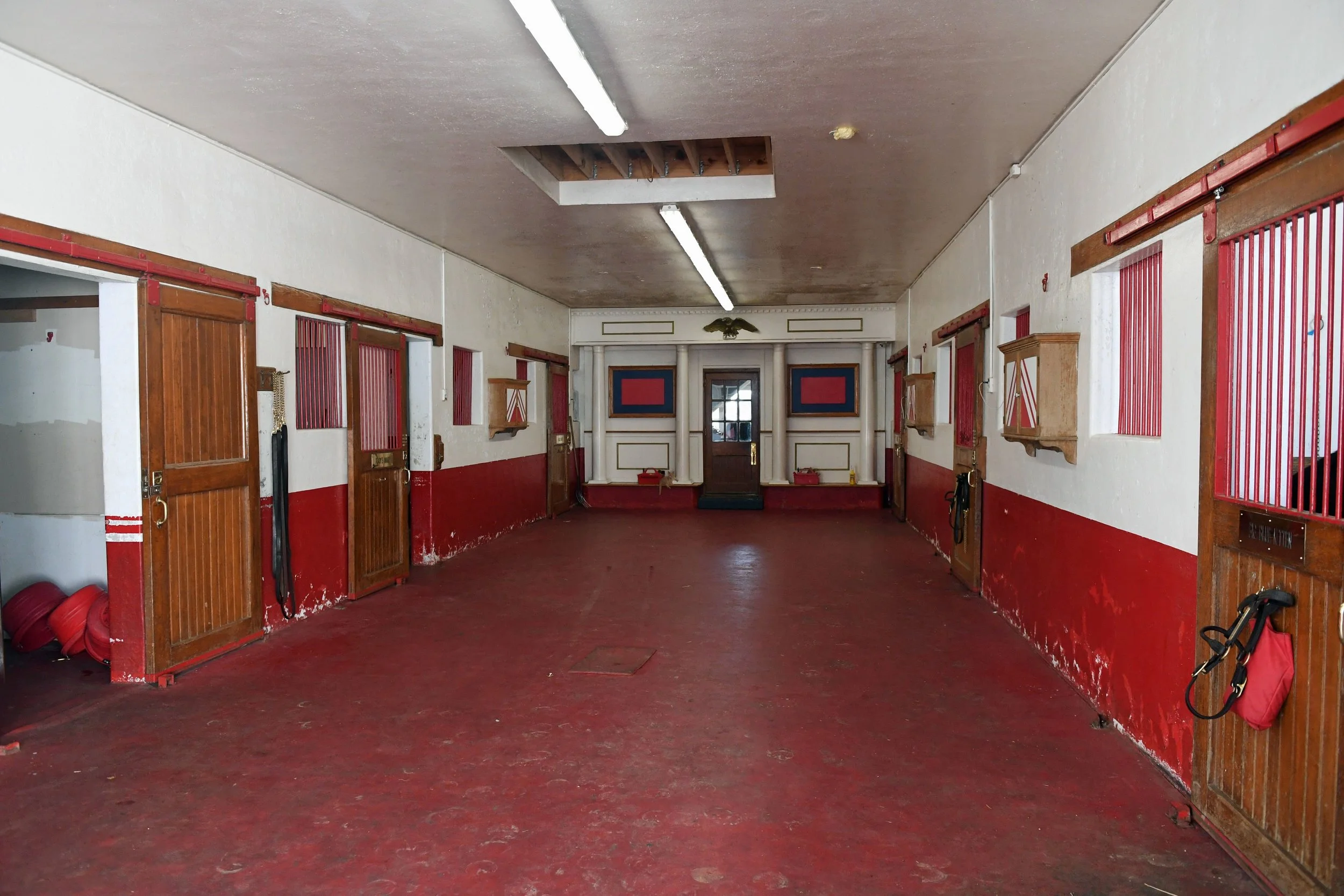





CALUMET FARM
By: Tom Ferry
I walked toward the stall and saw six nameplates on the door. The top plate said Alydar. I moved on to the next stall…Whirlaway. And the stall across the way…Citation. For lovers of the history of American Thoroughbred horse racing, there are few places that evoke the emotions one feels standing in the historic stallion barn at Calumet Farm.
Drive along both Versailles and Van Meter roads in Lexington, Kentucky and you can’t miss it. The white four-board fences, barns and outbuildings in white that are trimmed with rich green and red, and the distinctive red gate at the farm’s entrance. The numbers produced at these 762 acres are staggering. A record 8 Kentucky Derby winners, 2 Triple crown-winning colts and 3 Filly Triple Crown winners. The farm produced 11 horses that were inducted in the National Museum of Racing and Hall of Fame and 6 horses in the 1940s were named Horse of the Year.
It all began more than 100 years ago and 400 miles away from Lexington in Libertyville, Illinois. William Monroe Wright was the founding owner of the Calumet Baking Powder Company and loved Standardbred trotting horses. Ten years later in 1924, Wright relocated Calumet to Kentucky to take advantage of the more favorable climates for his horses. When Wright died in 1932, his son Warren Wright Sr. took over the business and set about converting Calumet into a Thoroughbred breeding and training operation. After Wright purchased interest in the successful European sire Blenheim II, he purchased a young colt in 1936 named Bull Lea who became the farm’s foundation sire and Calumet would soon become one of the most successful operations in Thoroughbred racing history.
For five decades, Calumet captured more than 2,400 wins with total earnings of over $26 million. The farm was the number one money earner in horse racing for twelve years. Its dominance of racing in the 1940s was unlike any stable before or since. Led by trainer Ben A. Jones and his son Jimmy, the Calumet reign would begin in 1941 when Whirlaway captured the Triple Crown. Soon to follow were championship seasons from Twilight Tear, Armed, Coaltown, Pensive and Ponder. In 1948, the great Citation became Calumet’s second Triple Crown winner in seven years and three years later “Big Cy” became the first Thoroughbred racehorse to win $1 million.
When Warren Wright died in 1950, his widow Lucille Parker Wright inherited Calumet and ran it successfully for more than 30 years. While the dominance of the 1940s had passed, the devil’s red and blue silks were continually showcased in winner’s circles across these decades and included Kentucky Derby wins in ’52, ’57, ’58 and ’68. Calumet rose to prominence again in the late 1970s behind trainer John Veitch and champions Our Mims, Davona Dale, and Before the Dawn. In 1978, a Calumet three-year-old superstar reminded racing fans of the farm’s glory days. His name was Alydar.
As part of one of the greatest rivalries in the sport’s history, Alydar finished a close second to eventual Triple Crown champion Affirmed in all three thrilling renditions of 1978’s classic races. He retired to stud the following year and became a major success for Calumet, siring such champions as Easy Goer, Alysheba, Strike the Gold and so many others. Despite his success, Alydar could not prevent the farm from entering a period of serious decline in the 1980s. When Lucille Wright Markey died in 1982, the farm passed to the heirs of Warren Wright. In 1990, Alydar was America’s leading sire but after his mysterious death on November 15 of the same year, a cloud of suspicion was cast over the business and accelerated Calumet’s continued collapse. Not long afterwards, the farm went bankrupt, dispersed its horses, and sold the original devil’s red and blue silks to a Brazilian investment group. In 1992, Calumet was put on the auction block.
And then everything changed overnight, and Calumet rose from the ashes.
Successful businessman Henryk de Kwiatkowski from Canada always admired the beauty of Calumet during his trips to Lexington. When he learned the farm was up for auction, he seized the opportunity and won ownership with a closing bid of $17 million. During the following ten years, Kwiatkowski and team restored Calumet to its former beauty. In 2012, The Calumet Investment Group purchased the farm for $35.9 million and leased the farm to American businessman Brad M. Kelley. The following year, Calumet won its eighth Preakness Stakes title when Oxbow captured the 138th running of the classic race wearing the farm’s new black silks with gold chevrons.
We will likely never see again the dominance achieved by Calumet in the 1940s, however, the farm has returned to eminence on the Thoroughbred racing stage. Brad Kelley has continued to invest both dollars and horses into the operation and this is evident today via a strong collection of twelve stallions. Stalls once occupied by the likes of Citation, Bull Lea and Tim Tam are now home to Oxbow, champion English Channel and Keen Ice. Calumet has never forgotten its past. The farm’s philosophy is to model the past and raise a good horse. And not just a good sales horse, but a good, sturdy two-turn Derby horse.
A visit to Calumet today is an echo of yesteryear. Thirty-five miles of iconic white fences surround the lush landscape. The farm’s training track, stables and barns have changed very little across 75 years. If walls could talk it would be fun to enter the two-and-one-half story brick Main House on the southwest corner of the property. And if the historic stallion barn is hallowed ground, Calumet’s equine cemetery is truly magical. Nearly 65 headstones provide a journey through racing history. So many champions who contributed to an incredible legacy of success. Perhaps the late, great sportswriter Red Smith described it best. “Calumet laid it over the competition like ice cream over spinach.”